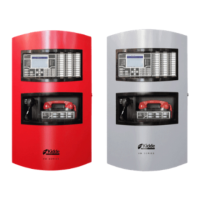Chapter 1: Introduction
2 VM-1 User Guide
System overview
The VM-1 control panel can operate as a stand-alone panel or as part of a
24-node VM-1 life safety network.
The VM-1 user interface contains operator controls and indicators that make you
aware of event activations and provide you with the ability to take action. When
an event occurs, the alarm state on the VM-CPU main board changes and
activates the control panel LEDs and buzzer, and displays an event message on
the 240 × 320 pixel liquid crystal display (LCD) screen. Alarm, supervisory,
trouble, and monitor event messages provide information that allows you to
locate the active point and respond accordingly.
The panel also gives you the ability to access message details and system
reports, and to enable and disable devices and groups. With the correct access
level passwords, you can activate and restore sensitivity settings and message
routing, test system devices, and other tasks.
System hardware capabilities
The VM-1 control panel, in its basic configuration, supports up to:
• 250 addressable devices
• Four Class B notification appliance or auxiliary power output circuits
• 30 remote or graphic annunciators for a total of 30 sets of common controls,
3,840 LED indicators, and 1,920 switches
• Two RS-232 ports (one RJ-11 modular jack for panel programming and
diagnostics and one terminal block connection for connecting accessory
devices)
With the proper hardware options, you can expand the VM-1 control panel to
support:
• 750 additional addressable devices (1,000 total)
• Four Class A notification appliance circuits
• Three reverse polarity outputs
• Three control-indicating modules for a total of 72 local LED indicators and
36 local switches
• Two dialer outputs

